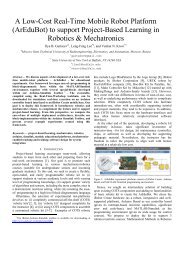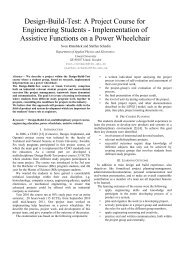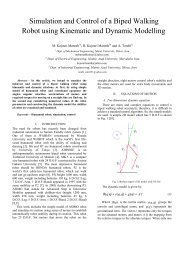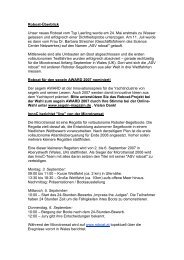The Kinect Sensor in Robotics Education - InnoC
The Kinect Sensor in Robotics Education - InnoC
The Kinect Sensor in Robotics Education - InnoC
Create successful ePaper yourself
Turn your PDF publications into a flip-book with our unique Google optimized e-Paper software.
depth data on a PC us<strong>in</strong>g the L<strong>in</strong>ux operat<strong>in</strong>g system with<br />
OpenGL and OpenCV libraries [4].<br />
<strong>The</strong> basic parts of the <strong>K<strong>in</strong>ect</strong> are (Fig. 2):<br />
RGB camera<br />
3D depth sens<strong>in</strong>g system<br />
Multi-array microphone<br />
Motorized tilt<br />
Fig. 3 Depth data without a threshold<br />
Fig. 2 <strong>The</strong> <strong>K<strong>in</strong>ect</strong> sensor<br />
<strong>K<strong>in</strong>ect</strong> is able to capture the surround<strong>in</strong>g world <strong>in</strong> 3D by<br />
comb<strong>in</strong><strong>in</strong>g the <strong>in</strong>formation from depth sensors and a standard<br />
RGB camera. <strong>The</strong> result of this comb<strong>in</strong>ation is an RGBD<br />
image with 640x480 resolution, where each pixel is assigned a<br />
color <strong>in</strong>formation and a depth <strong>in</strong>formation (however some<br />
depth map pixels do not conta<strong>in</strong> data, so the depth map is<br />
never complete). In ideal conditions the resolution of the<br />
depth <strong>in</strong>formation can be as high as 3 mm [3], us<strong>in</strong>g 11 bit<br />
resolution. <strong>K<strong>in</strong>ect</strong> works with the frequency 30 Hz for both<br />
RGB and depth cameras. On the left side of the <strong>K<strong>in</strong>ect</strong> is a<br />
laser <strong>in</strong>frared light source that generates electromagnetic<br />
waves with the frequency of 830 nm. Information is encoded<br />
<strong>in</strong> light patterns that are be<strong>in</strong>g deformed as the light reflects<br />
from objects <strong>in</strong> front of the <strong>K<strong>in</strong>ect</strong>. Based on these<br />
deformations captured by the sensor on the right side of RGB<br />
camera a depth map is created. Accord<strong>in</strong>g to PrimeSense this<br />
is not the time-of-flight method used <strong>in</strong> other 3D cameras [5].<br />
III. BASIC ADVANTAGES<br />
<strong>The</strong> first and major advantage of <strong>K<strong>in</strong>ect</strong> <strong>in</strong> robotics and the<br />
educational process is its impact on image segmentation tasks.<br />
<strong>The</strong> simplification comes from the depth data. With a s<strong>in</strong>gle<br />
camera it is impossible to dist<strong>in</strong>guish objects of similar colors.<br />
For <strong>in</strong>stance, if a white box stands 1 meter <strong>in</strong> front of a white<br />
wall a robot with a camera is not able to f<strong>in</strong>d differences<br />
between these two objects from the RGB data. However, with<br />
the <strong>K<strong>in</strong>ect</strong> provid<strong>in</strong>g a 3D map the segmentation is very<br />
simple us<strong>in</strong>g just a s<strong>in</strong>gle distance threshold. Without its<br />
application, there is a lot of noise and unwanted objects <strong>in</strong> the<br />
image (Fig. 3). After its application the desired objects can be<br />
easily segmented (Fig. 4).<br />
Fig. 4 Depth data with the threshold applied<br />
Us<strong>in</strong>g this threshold<strong>in</strong>g method is great for the educational<br />
process, because students can immediately see the results of<br />
the operations applied, whereas with IR or ultrasonic sensors<br />
they see only numerical output provided by the<br />
microcontroller via serial <strong>in</strong>terface and have to <strong>in</strong>terpret the<br />
data themselves. With 3D data comb<strong>in</strong>ed with color RGB data<br />
a lot of this <strong>in</strong>terpretation is <strong>in</strong>tuitive and automatic.<br />
IV. APPLICATIONS<br />
<strong>The</strong> <strong>K<strong>in</strong>ect</strong> sensor can be used <strong>in</strong> a variety of robotics<br />
applications be<strong>in</strong>g an addition to older methods or a complete<br />
substitution. Students can compare the pros and cons of<br />
several approaches and f<strong>in</strong>d out first-hand what suites their<br />
particular project more.<br />
A. Data Fusion<br />
Students can learn to fuse different data. <strong>The</strong> RGB<br />
<strong>in</strong>formation can be converted to any commonly used color<br />
space, such as Normalized RGB, HIS, HSV, HSL, TSL,<br />
YCbCr, CIELAB or CIELUV. All of these color spaces are<br />
commonly used for different tasks <strong>in</strong> visual systems<br />
applications. One of their primary utilizations is object<br />
detection and segmentation, which is also used <strong>in</strong> computer








